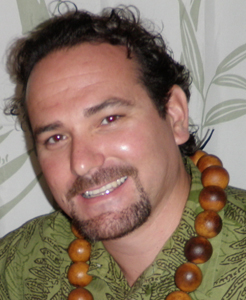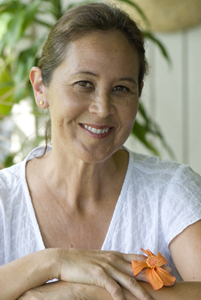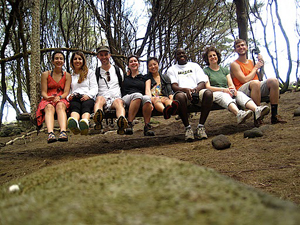 Photo: Yale team members in Pololū Valley. (From left to right) Mariana Sarmiento, Stefania Panousi, Andrew Bostrom, Lauren Barredo, BinBin Jiang, Troy Savage, Professor Marian Chertow, and Ezekiel Fugate.
Photo: Yale team members in Pololū Valley. (From left to right) Mariana Sarmiento, Stefania Panousi, Andrew Bostrom, Lauren Barredo, BinBin Jiang, Troy Savage, Professor Marian Chertow, and Ezekiel Fugate.
The main focus of the ULTRA-EX project is to compile a contemporary snapshot and historical understanding of the urban areas of Hawai‘i Island, Hilo, and Kailua-Kona, by taking a closer look at their energy, water, and material systems. In September 2009, Principal Investigator (PI) Marian Chertow and three other PIs, Professor Karen Seto, Dr. Kamana Beamer of The Kohala Center, and Dr. Christian Giardina of the Institute of Pacific Islands Forestry - USDA Forest Service received a grant from the National Science Foundation under the Urban Long-Term Research Area - Exploratory Awards, or ULTRA-EX program. The four research projects launched in March 2010 will provide valuable data and insights to ULTRA-EX researchers about material flows and consumption patterns on Hawai‘i Island.
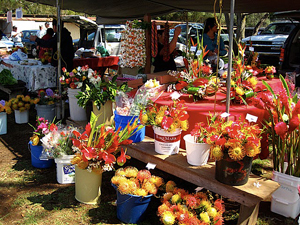 Photo: A visit to the Waimea Homestead Farmers’ Market. Photo by Lauren Barredo.
Photo: A visit to the Waimea Homestead Farmers’ Market. Photo by Lauren Barredo.
From March 7–14, twelve Yale industrial ecology students, mostly master's candidates from the School of Forestry and Environmental Studies, conducted field research on Hawai‘i Island under the direction of Professor Marian Chertow. While on the island, the students met with County officials, representatives from private companies, and community members in order to gather data related to their research. The students were also oriented to cultural and socioeconomic issues on the island by Kohala Center staff.
Students were divided into teams and assigned to the following four research projects:
Project 1 – Energy
Hawai‘i Island meets approximately 90% of its energy needs with imported petroleum-based fuels. These energy resources must travel a minimum distance of 2,400 miles from the nearest continental shoreline. As a result, energy prices in Hawai‘i are among the most expensive in the United States. This project will analyze energy systems and energy use in the island's two major urban areas—Hilo and Kailua-Kona. This study will consider energy use by various sectors of the island economy, including buildings and facilities, transportation, food production, water and wastewater processing, and manufacturing.
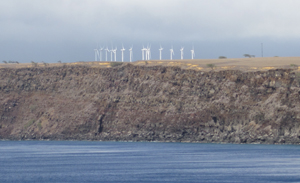
The Yale Energy Team consists of Gabriel Mejias, Christopher Cooke, and Lauren Barredo. Team members met with representatives of HELCO, Puna Geothermal Venture (PGV), Hawai‘i County Department of Research and Development, and UH Hilo, and toured several renewable power facilities. At PGV students witnessed the drilling of a new geothermal well at a depth of over 3,100 feet beneath their feet. “We were amazed to realize by the potential for renewable energy on the island,” remarked team member Gabriel Mejias.
Project 2 – Water and Wastewater Systems
Water is a precious resource on Hawai‘i Island. Hilo, on the windward side of the island, is one of the rainiest urban centers in the nation, receiving an average of 3,300 mm of rainfall each year. In contrast, Kailua-Kona, on the leeward side of the island, receives nearly 13 times less rainfall in a typical year and is currently experiencing extreme drought conditions. Despite this drastic difference, these two areas have similar water consumption rates, leading to substantially more pumping, storage, and import in Kailua-Kona. This project will analyze water and wastewater systems in the two major urban areas on the island with the goal of quantifying water and wastewater flows across all sectors of the economy.
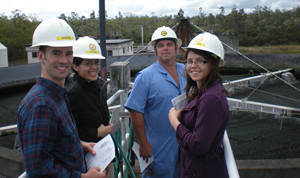 Photo: (From left to right) Water Team members Andrew Bostrom, Amanda Chavez Kupp, Casey Mullins (plant employee), and Melissa Ivins standing on the trickling filter tower at the Hilo Wastewater Treatment Plant.
Photo: (From left to right) Water Team members Andrew Bostrom, Amanda Chavez Kupp, Casey Mullins (plant employee), and Melissa Ivins standing on the trickling filter tower at the Hilo Wastewater Treatment Plant. The Yale Water Team consists of Andrew Bostrom, Amanda Chavez-Kupp, and Melissa Ivins. The team met with representatives of the State’s Clean Water Branch, Hawai‘i County Department of Water Supply, and private resorts, and they toured the Hilo and Kona wastewater treatment plants. Andrew Bostrom shared these comments on behalf of the Water Team, “We were surprised at the optimism for the supply of water in Kona, despite uncertainty in sustainable yield estimates and persistent drought conditions. We were delighted, but not surprised, to have reported to us that the quality of the water in the ocean near beaches consistently passed health standards, though we were concerned by another report of vulnerability of coral to water pollution. We enjoyed the tours of the wastewater treatment plants, particularly the endangered species of birds that inhabit the settling lagoons at the Kona plant.”
Project 3 – Inputs (Imports, Domestic Extraction, and Additions to Stocks)
With more than half of the world's population now living in cities, urban areas demand substantial flows of material resources to sustain themselves. On Hawai‘i Island, an initial material flow analysis showed that 76% of inputs to the island's economy are imported from off the island, and the majority of materials extracted on the island are used in construction. In total, the island generates 800 tons of waste material every day.

This project will broadly focus on the left-hand side of the material flow diagram above by examining imports (raw and processed), domestically extracted materials, and changes in the material stocks of Hilo and Kailua-Kona. This study will utilize building and infrastructure records to analyze changes in the built environment in both urban areas.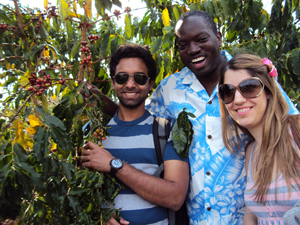
The Yale Inputs Team consists of Stefania Panousi, Srinath Sabapathy, and Troy Savage. Team members visited a water bottling plant, a coffee farm, a macadamia nut processing facility, a construction contractor’s baseyard, a major supermarket, and various hotels around the island. “We were amazed by the fact that almost all the products consumed on the island are imported. Most imports arrive via ship. Consequently, it is undeniable that the sea is very significant to the Hawaiians,” remarked Inputs Team member Stefania Panousi.
Photo: (From left to right) Inputs Team members Srinath Sabapathy, Troy Savage, and Stefania Panousi at Greenwell Coffee Farm in Kona, touring the site.Project 4 – Outputs (Exports, Wastes, and Recycling)
With only two landfills on the island, waste management and prevention is a pressing issue. The Hilo landfill that services the entire east side of the island has exceeded its capacity, yet there is local resistance to trucking waste cross-island to the landfill in West Hawai‘i and some discussions have focused on exporting waste off the island. This project will focus on the right-hand side of the material flow diagram by examining wastes and recycling in Hilo and Kailua-Kona, in addition to surveying all exports from these areas. This study will utilize data from the recently completed County of Hawai‘i Integrated Solid Waste Management Plan.
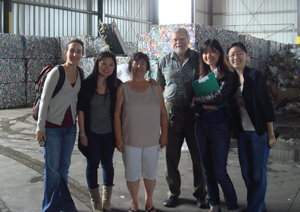
The Yale Outputs Team consists of Mariana Sarmiento, Tian Wang, and Mona Yang. This team visited the island’s two landfills, recycling facilities around the island, sewage treatment plants, hotels, and Parker Ranch. Team member Tian Wang commented that at 198 feet in height, the Hilo landfill is an impressive sight to behold. Tian also shared these thoughts on behalf of the Outputs Team, “We spent five days on Hawai‘i Island driving back and forth from the east side to the west side, gathering as much information as we possibly could on waste production and management, recycling, and exports. We talked with county officials, recycling businesses, and agricultural producers, all of whom helped us to understand the controversial waste management practices on the island, as well as the changes in exports that have occurred over time.”
In addition to their research, the Yale students had the opportunity to experience many of the island’s best sights, sounds, and tastes. Highlights of their visit included a Puana Ka ‘Ike lecture by Dr. Keanu Sai on King Kamehameha III and the transformation of Hawaiian land tenure, hikes into Waipi‘o and Pololū Valleys, a trek into Hawai‘i Volcanoes National Park, and visits to Pu‘ukoholā Heiau, Mauna Kea Beach Resort, Hāpuna Beach, Kekaha Kai State Park, and Kahalu‘u Bay. Students also enjoyed local eateries and an evening with the Cornell students in the Earth and Environmental Systems Field Program, 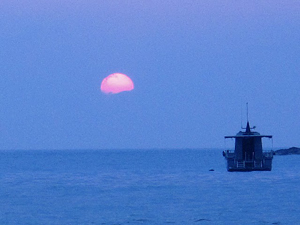 who treated the Yale students to a smorgasbord of freshly prepared, locally sourced delicacies.
who treated the Yale students to a smorgasbord of freshly prepared, locally sourced delicacies.
In May 2010, the students will submit final reports on their team research projects as part of the requirements for a course in industrial ecology taught by Yale Professors Marian Chertow and Thomas Graedel. These reports, the first essential pieces of the larger ULTRA-EX project, will form the foundation of a contemporary and comparative analysis of material, energy, and water flows in Hilo and Kona. And they will also provide the springboard for further research into the historical components of the ULTRA-EX project. Look for the initial results of these research projects on The Kohala Center’s Web site in fall 2010.

The first HICES cohort consists of 20 pre-service teachers who make regular visits to lower elementary school classrooms at Connections Public Charter School and Keaukaha Elementary School. The teacher candidates deliver science and environmental education lessons utilizing curriculum focusing on Hawai‘i’s rocky shorelines and coral reefs. The HICES project is currently working with three 2nd grade classes at Keaukaha Elementary School and four kindergarten through 3rd grade classes at Connections Public Charter School.
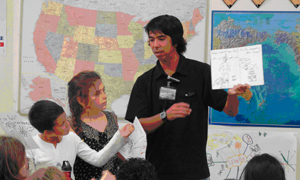 “It is exciting when you see UHH Education students enthusiastically working closely with very young children,” shares Darius Kalvaitus. “Everyone is having a lot of fun learning about something that connects us all here in Hawai‘i—the ocean. Our HICES pre-service teachers know that students learn best through fun activities and hands-on experiences,” says Kalvaitus.
“It is exciting when you see UHH Education students enthusiastically working closely with very young children,” shares Darius Kalvaitus. “Everyone is having a lot of fun learning about something that connects us all here in Hawai‘i—the ocean. Our HICES pre-service teachers know that students learn best through fun activities and hands-on experiences,” says Kalvaitus.
The elementary students are excited to learn about ocean critters and how to protect them in their own classrooms. A second grade student commented, “I like to help the ocean by cleaning up rubbish. I also like to see the animals and play with the animals in the ocean.” Classroom learning is extended when the children attend HICES field trips to local sites, including Mokupapapa’s Discovery Center’s science wet-lab where they engage in hands-on activities involving the ocean animals they have been studying.
The work of the first HICES cohort will be highlighted at a culminating event at Mokupapapa Discovery Center in downtown Hilo from 9 to 11:30 a.m on Saturday, April 24. This celebratory event will include demonstrations of student work, HICES film screenings, and service learning projects for keiki, parents, and community members.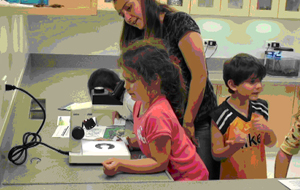
It is important to promote students’ interests in ocean science and stewardship as early as possible in order to facilitate their learning and give them chances to develop a caring ethic for the ocean and coastlines here in Hawai‘i. The HICES project does just that. –Hoʻoululāhui Erika Perry, HICES Project Facilitator
For more information or to get involved in the HICES project, please contact Perry via e-mail at hperry@hawaii.edu.

Kamana Beamer was among the first cohort in the Mellon-Hawai‘i Fellowship Program which supports Native Hawaiian scholars who are committed to the advancement of scholarship on Hawaiian cultural and natural environments, Hawaiian history, politics, and society. The program provides Native Hawaiian scholars the opportunity to complete their dissertations or to publish original research. A graduate of Kamehameha Schools in Honolulu, Beamer received bachelor’s degrees in Hawaiian studies and philosophy, and his master’s and doctorate degrees in geography from the University of Hawai‘i at Mānoa.
During the Mellon-Hawai‘i Fellowship year, Beamer completed a book manuscript, Na Wai Ka Mana? Native Agency and European Imperialism in the Hawaiian Kingdom, now under consideration by university presses. His research is published in:
- Journal of Historical Geography;
- AlterNative, An International Journal of Indigenous Scholarship; and
- Hawaiian Journal of Law and Politics.
In addition to his scholarly pursuits, Beamer is a taro farmer who continues to maintain his family taro farm in Waipi‘o Valley on Hawai‘i Island. He also perpetuates the musical traditions of the Beamer family as a recording artist.
The Mellon-Hawai‘i Fellowship, established by The Andrew W. Mellon Foundation, Kamehameha Schools, and The Kohala Center, aims to develop intellectual and scholarly leadership from Hawai‘i—for Hawai‘i and the world. The fellowship program was established in the academic year 2008–2009. The third cohort of Mellon-Hawai‘i Fellows will be announced in April 2010.
Read "A Brighter Future,” a brief autobiographical sketch by Kamana Beamer in the March 2009 Leaflet.

On April 24 from 1 to 5 pm, Garden Teachers Donna Mitts (Pa‘auilo School) and Chioke Mims (HAAS) will lead participants through an exercise in painting with garden objects. “This activity will help foster imagination and creativity and help to deepen our appreciation of the beauty found in our gardens,” says Donna.
Photo: Janice Crowl.Children’s author Janice Crowl will read from her story Pulelehua and Mamaki and discuss its various themes. Participants will learn the different parts of the mamaki plant and their cultural uses, and they’ll propagate mamaki to take back to their own gardens. They’ll also learn how to find and identify the native Kamehameha butterfly in various stages of its life cycle, learn why this butterfly is so special, and discover where it can be seen in nature.
"Pulelehua and Mamaki was specifically written to use in Hawai‘i school garden programs, with consideration given to Hawai‘i Content and Performance Standards and place-based education,” explains Janice. “There are plenty of books about the non-native Monarch butterfly and its habitat in North America, but I wanted to create a narrative that helps our mission to teach keiki about Hawai‘i's own unique cultural and ecological heritage. Pulelehua and Mamaki celebrates our interrelationships—to our families, our communities, and our environment,” she says.
Cellist Nelson Denman will help participants to write stories, songs, and poems which reflect their multicultural, interdisciplinary garden wisdom. Participant’s work will be added to the existing Literature in the Garden Curriculum used by HISGN schools. “To inspire the creative genius within each of us, I will be playing solo cello and guitar and telling stories from my new musical CD entitled Songs and Stories of the Healing Island,” explains Nelson.
To cultivate the connections between children’s gardening experiences and great books, the Junior Master Gardener (JMG) program developed the Literature in the Garden series. This curriculum utilizes Growing Good Kids Book Award-winning titles to inspire learning through outdoor activities, creative expression, and open exploration. Becky Settlage will familiarize participants with the JMG Literature in the Garden curriculum. She will also make available other JMG resources for participants to view and will explain how folks can become involved with the Junior Master Gardener Program. “I would like to continue Growing Great Kids by introducing teachers and youth to some of the great resources from the Junior Master Garden Program,” says Becky.
To register for the “Art, Literature, and Music in the School Garden” workshop or for more information, please call Donna Mitts at (808) 333-5649 or (808) 936-2117.


